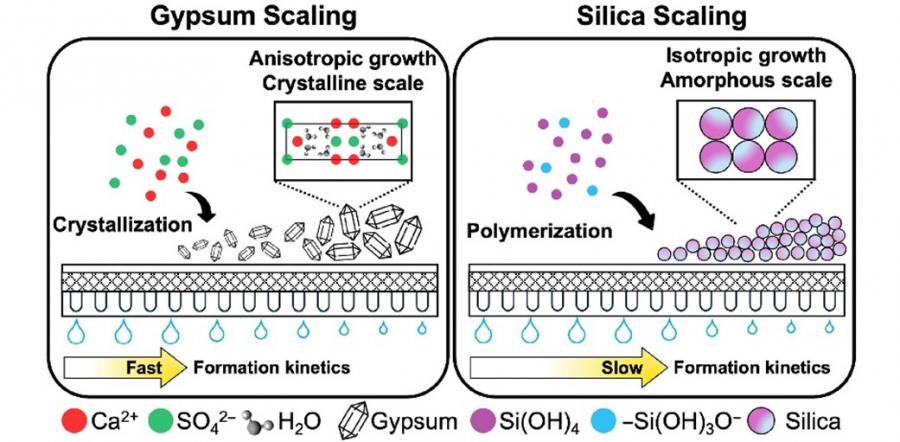
Explores the Impact of Gypsum and Silica Scaling in Water Desalination
GA, UNITED STATES, January 17, 2025 /EINPresswire.com/ -- A recent review provides a detailed comparison of gypsum and silica scaling in membrane desalination, shedding light on their unique formation mechanisms and behaviors. The research identifies the challenges each scaling type poses to desalination efficiency and highlights critical differences in how they interact with organic foulants. By understanding these distinct behaviors, the study offers valuable insights that can inform targeted strategies for improving desalination processes and their sustainability.
Mineral scaling, a significant issue in membrane desalination, reduces water recovery rates and diminishes system performance. Gypsum and silica, are two prevalent types of scaling, each form through different processes—crystallization for gypsum and polymerization for silica. These formation mechanisms lead to contrasting behaviors: gypsum scaling, marked by rapid kinetics and intrusive crystal growth, causes pore wetting, while silica scaling forms highly adhesive, irreversible layers. The impact of these scales on desalination efficiency underscores the need for a deeper understanding of their formation and mitigation.
On October 20, 2024, researchers from Arizona State University and Colorado State University published a pivotal review (DOI: 10.1007/s11783-025-1923-9) in Frontiers of Environmental Science & Engineering. The study meticulously examines the contrasting behaviors and mitigation strategies of gypsum and silica scaling in membrane desalination processes.
The research provides an in-depth analysis of gypsum and silica scaling, offering insights into their distinct behaviors. Gypsum scaling occurs through the crystallization of calcium sulfate, resulting in rapid kinetics and directional crystal growth. These large, high-aspect ratio crystals can intrusively penetrate membrane pores, leading to issues like pore wetting in membrane distillation. The presence of organic foulants complicates gypsum scaling, as some substances can inhibit crystal growth through adsorption. In contrast, silica scaling arises from the polymerization of silicic acid, producing amorphous, adhesive scales that form a gel-like layer on membranes, causing nearly irreversible flux decline. Silica scaling is less responsive to membrane surface properties, making it more challenging to mitigate. The study also outlines various strategies for addressing each scaling type. For gypsum scaling, hydrophilic polymer brushes and zwitterionic coatings show promise, while silica scaling may benefit from modified membrane surface charges to promote electrostatic repulsion. Additionally, the use of antiscalants and pretreatment methods like electrocoagulation is explored.
Dr. Tiezheng Tong, a leading researcher in the study, emphasized, "Our comprehensive analysis of gypsum and silica scaling provides a foundation for developing more targeted and efficient strategies to combat mineral scaling in desalination. This research is crucial for improving the sustainability and efficiency of water treatment processes."
The findings have significant implications for the desalination industry, offering strategies that can help prevent or mitigate scaling. By tailoring membrane surface properties, selecting appropriate antiscalants, and employing pretreatment methods, researchers and engineers can improve desalination efficiency and extend system longevity. These advancements not only enhance water recovery rates but also contribute to the broader goal of sustainable water management, particularly in areas facing water scarcity, by ensuring more efficient and reliable desalination processes.
DOI
10.1007/s11783-025-1923-9
Original Source URL
https://doi.org/10.1007/s11783-025-1923-9
Funding information
This material was based upon work supported by the National Science Foundation (Nos. 2143970 and 2145627).
Lucy Wang
BioDesign Research
email us here
Distribution channels: Environment, Science, Technology
Legal Disclaimer:
EIN Presswire provides this news content "as is" without warranty of any kind. We do not accept any responsibility or liability for the accuracy, content, images, videos, licenses, completeness, legality, or reliability of the information contained in this article. If you have any complaints or copyright issues related to this article, kindly contact the author above.
Submit your press release
